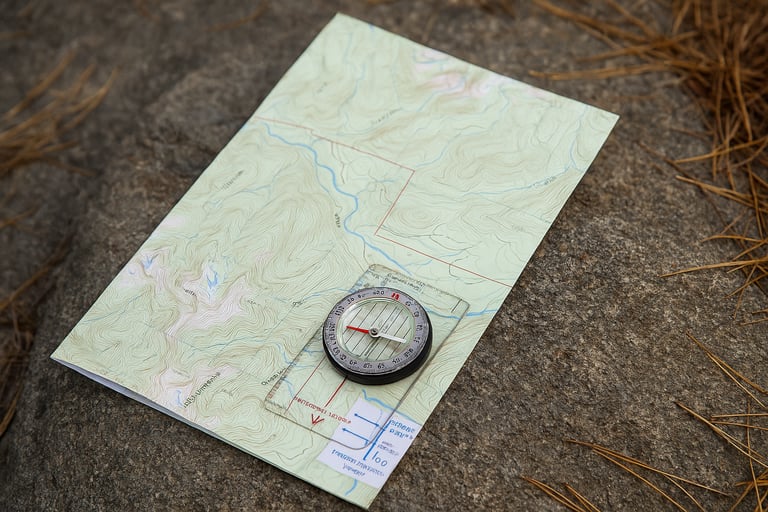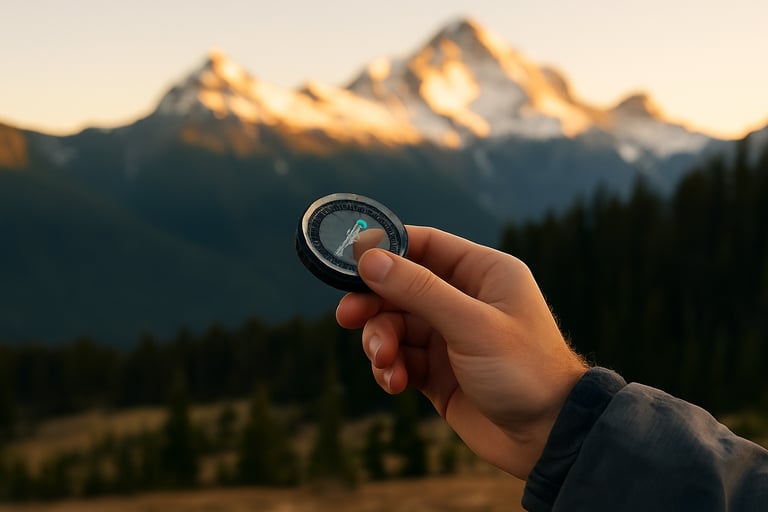Wilderness Navigation & Magnetic Declination: What It Is & Why It Matters for Survival
Learn how magnetic declination affects wilderness navigation and survival. This guide explains what declination is, why it matters, and how to use it correctly with your compass during backcountry travel.


Wilderness Navigation & Magnetic Declination: What It Is & Why It Matters for Survival
Understanding Magnetic Declination in Survival Navigation
When you're exploring the wilderness with just a compass and topographic map, magnetic declination is one of the most important things to understand. In basic terms, it’s the difference between true north — the direction maps are drawn to — and magnetic north — the direction your compass needle actually points.
This angle varies depending on your location on Earth. Sometimes it’s just a few degrees, but even a small difference can throw you off course if you don’t account for it. For those navigating in the backcountry or in a wilderness survival situation, ignoring magnetic declination can lead to serious directional errors.
Why Declination Matters for Wilderness Survival
In the context of survival, precise navigation isn’t optional — it’s essential. If you miscalculate your heading by even a few degrees over long distances, you can easily drift far from your intended path. That can mean missing trails, water sources, or your exit route entirely.
In wilderness environments where landmarks are scarce and weather can shift quickly, understanding and adjusting for magnetic declination can make the difference between staying on course or becoming disoriented. For survivalists and outdoor adventurers alike, it's a fundamental skill. And to avoid getting turned around, it helps to know What to Do If You're Lost in the Wilderness: Navigation Strategies to Find Your Way Back.
How to Find the Declination for Your Area
Magnetic declination isn’t a fixed number — it changes depending on where you are, and even slightly over time. Maps will often print the local declination in the legend or corner of the map. You can also look it up online using a GPS coordinate tool or a site like NOAA’s magnetic declination calculator.
Make sure you check the date on your map. If it’s more than a few years old, the declination value may have shifted. Knowing your location-specific declination ensures you adjust your compass correctly.
Adjusting Your Compass for Accurate Navigation
There are two ways to adjust for magnetic declination:
The first is manual compensation. If your area has a declination of 10° east, you would turn your compass 10° west of your intended heading to stay on track. If it’s 10° west, you’d adjust 10° east.
The second method is adjusting your compass itself. Many modern compasses allow you to set the declination using a small adjustment screw. Once set, you don’t have to calculate each time — your compass accounts for it automatically. And remember — tools only work if you understand how to use them correctly (If you’re still building your backcountry skills, make sure you’ve reviewed 10 Essential Wilderness Navigation Tips to Avoid Getting Lost).
Both approaches work, but if you’re traveling in remote areas often, a compass with built-in declination adjustment is a smart investment.
When and Where Declination Makes the Biggest Difference
In some places, the difference between true north and magnetic north is negligible, maybe only 1 or 2 degrees. But in others, especially along the east or west coasts of North America, the variation can be over 15 degrees. The further you travel and the rougher the terrain, the more crucial it is to correct your heading.
In survival scenarios, where you’re building shelters, hunting for water, or navigating away from danger — even small navigational errors can compound quickly. That’s why it’s essential to always factor in magnetic declination when navigating with a map and compass. When venturing far off-trail, pairing solid navigation with Essential Safety Skills for Outdoor Emergencies can help prevent small mistakes from turning into dangerous situations.
Final Thoughts: Mastering Magnetic Declination for Backcountry Safety
Navigating in the wilderness isn’t just about knowing where north is — it’s about understanding how the environment affects your tools. Magnetic declination is one of those invisible factors that can throw your navigation off if you’re not paying attention.
Take the time to learn how to read your map’s declination, adjust your compass properly, and test yourself before you need the skill in a survival situation. With a little practice, you’ll navigate smarter, safer, and with more confidence every time you step into the wild.




© 2025. All rights reserved About | Privacy Policy | Terms and Conditions | Affiliate Disclosure | Disclaimer


